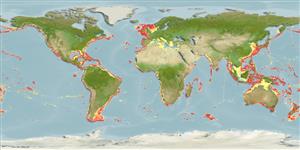Classificação / Names
Common names from other countries
Referência principal
Tamanho / Peso / Idade
Max length : 445 cm TL macho/indeterminado; (Ref. 106604); common length : 270 cm TL macho/indeterminado; (Ref. 5217); Peso máx. publicado: 505.8 kg (Ref. 4699); Idade máx. registada: 32 anos (Ref. 86588)
Length at first maturity
Lm 277.5, range 275 - 285 cm
Ambiente
; marinhas; oceanódromo (Ref. 51243); intervalo de profundidade 0 - 750 m (Ref. 106604), usually 100 - 150 m (Ref. 36731)
Clima / Intervalo
Subtropical; 16°C - ? (Ref. 9988), preferred 26°C (Ref. 107945); 61°N - 56°S, 180°W - 180°E
Distribuição
Cosmopolitan in temperate and tropical seas (Ref. 6871, 11230). Western Atlantic: Gulf of Maine to southern Brazil and Argentina (Ref. 58839), including the Gulf of Mexico and Caribbean. Eastern Atlantic: Norway to South Africa, including the Mediterranean. Indo-Pacific: East Africa to Hawaii, north to Primorskiy Kray (Russian Federation), south to Australia and New Zealand. Eastern Pacific: south of Aleutian Islands and from southern California, USA to Chile.
Países | Áreas FAO | Ecossistemas | Ocorrências | Introduções
Descrição breve
Espinhos dorsais (total): 0; Raios dorsais moles (total): 0; Espinhos anais 0; Raios anais moles: 0. A large, spindle-shaped shark with large black eyes, a sharp snout, and large, narrow, hooked teeth with smooth edges (Ref. 5578). Caudal fin lunate, lower lobe strongly developed (Ref. 13574). Dark blue above, white below (Ref. 6581). Tiny second dorsal and anal fins (Ref. 26938).
Categoria na Lista Vermelha da IUCN (Ref. 115185)
Utilização humana
Pescarias: pouco comercial; peixe desportivo: sim
Ferramentas
Relatórios especiais
Descarregue XML
Fontes da internet
Estimates of some properties based on models
Phylogenetic diversity index
PD50 = 0.7813 many relatives (e.g. carps) 0.5 - 2.0 few relatives (e.g. lungfishes)
Nível Trófico
4.5 ±0.0 se; Based on diet studies.
Resiliência
Muito baixo, tempo mínimo de duplicação da população maior que 14 anos (rm=0.051; K=0.2; tmax=28; tm=20; Fec=4)
Vulnerabilidade
Very high vulnerability (83 of 100)
Categoria de preço
